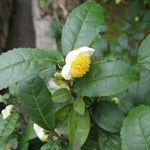Subscribe and save 10%!

Tea bush (Camellia sinensis)
52 SEK
Unit price perExpected delivery date: 20 December to 27 December.
Applies to orders within Sweden. For other countries - see our delivery terms .
In stock - Ready to be shipped
Share
SEEDS (4pcs/bag)
Common name: Tea Plant, Tea Shrub, Tea Tree
Scientific name: Camellia sinensis
Family: Theaceae
Plant history & use:
Tea is consumed worldwide as the second most common beverage after water. The tea bush contains theine, which counteracts fatigue, and theanine , which provides a calming effect, unlike coffee, which only has the invigorating properties of caffeine (=theine). A cup of tea can therefore be invigorating and calming at the same time.
It is mainly leaf buds and young leaves that are picked to brew tea with, but sometimes the flowers are also used. The younger the shoots/leafs, the higher quality tea.
From the tea bush Camellia sinensis, you can make different types of tea: white, yellow, green, blue (oolong), black and "dark" tea. The difference between them is defined by different fermentation and oxidation processes. White tea is not even allowed to oxidize, while "dark" tea is allowed to both oxidize and ferment for long periods. The types in between are gradually more or less in one direction or the other, in the order stated. All types have their health benefits, sometimes differing.
Red tea (rooibos) comes from another species, the Rooibos bush Aspalathus linearis .
The tea leaves are also used for cooking in Asia - for example Tea Lead Salad (fermented leaves) in Burma and (fresh leaves) in Thailand.
Cultivation:
The exact origin of the Tea bush is debated, although it has been pinned down that it originates from an area south-east of the Tibetan plateau: between China, Thailand, Myanmar (Burma) and north-east India.
The Tea bush was first cultivated in ancient China and not introduced to Europe until the 17th century - only to be spread by colonialists for cultivation in India, Africa and Indonesia.
The first sights of an established plantation in Europe was not until the late 19th century - in the Azores islands of Portugal. Shortly after emerges cultivations in Georgia, Turkey and Russia which still to this day are the largest tea producers in Europe.
A southern European climate can be a great match for growing tea, especially on locations with a slightly humid, subtropical and hilly environment with mild winters and long summers. Similar to that of Georgias hillside tea plantations, for example.
Northern Europe has its fair share of successful tea plantations as well, maybe with UK Tregothnan as one of the first. Recent years has seen an increase in northern European tea cultivations, ranging from Belgium all the way up to Sweden. And they are operating well. What this tells us is that cultivating tea is actually possible in most parts of Europe, just spend a bit of your power of thought to find (or create) the right spot.
The tea bush naturally grows at high altitudes where it gets colder at night, and it may also be chilly during daytime. It prefers a location sheltered from wind, as it slows down leaf growth. It does not like to grow in shade however, the optimal location is an environment with lots of light.
It prefers a well-drained soil - not a permanently moist soil, neither a drought susceptible soil. In optimal conditions the water just flushes through regularly, leaving the soil free to dry up in between flushes.
Reading the above preferations, you may start to realize why a sloping hillside environment is the natural environment of the tea bush. A hillside climate is not a must though, many of the successful European cultivations are grown on plain land. Just try to mimic the preferred conditions as much as you can, with whatever means you have available to the degree that you can.
The tea bush can be overwintered outdoors in most of Europe, depending on location and conditions the plants may need to be covered during wintertime - e.g. straw, bark or similar.
Tea thrives in acidic soil, use Rhododendron soil when repotting the plant the first time.
Sowing:
Before sowing the seeds, soak them in water for 1 day (put something on top to press down the seeds in case they float). Then put the seeds on a piece of damp paper, put the paper with the seeds inside a sealed plastic bag in room temperature for a day. Then, sow in a pot and cover with 1-2 cm of soil. If germination has not occurred within a month, place the pot with the seeds in the refrigerator for about 1 month. Then take it out and let germinate.
Characteristics:
Lifespan: Perennial
Location: Sun/Part shade
Height: 1-2 meters
Germination Time: 1-3 months
USDA Zones: 7-9
- Choosing a selection results in a full page refresh.
- Opens in a new window.













